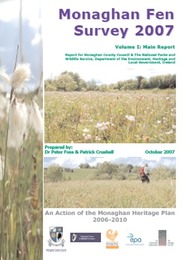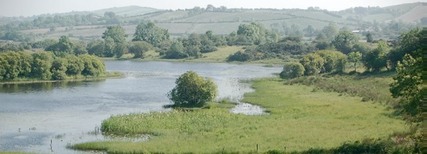Foss, P.J. & Crushell, P. (2007) Monaghan Fen Survey. Volumes 1-3. Report for Department of the Environment, Heritage and Local Government, Ireland & Monaghan County Council.

The Monaghan Fen Survey I of fens in county Monaghan was commissioned by Monaghan County Council and the National Parks and Wildlife Service (NPWS) of the Department of the Environment, Heritage and Local Government. The survey was an Action of the Monaghan Heritage Plan 2006-2010.
There were two principal reasons for undertaking the survey in 2007, namely to devise a fen survey methodology which could be applied to a National Fen Survey of the entire country, to be undertaken by the NPWS, and the second was to obtain data on existing and newly proposed fen sites reported in 2006 in County Monaghan to the NPWS Fen Study Project (Foss 2007).
The Monaghan Fen Survey 2007 addressed the following research objectives:
• to describe the vegetation of each site with particular emphasis on the fen communities that are present;
• identify and classify the key fen habitat and vegetation types present on each site according to the scheme proposed in Foss (2007), and in this report;
• ascertain the extent of the fen type(s) present and the overall site extent, and map these fen habitats together with the other main habitats identified;
• investigate the water chemistry parameters of each site and relate it to the fen communities that occur;
• measure peat depth associated with the fen types recorded;
• identify the main threats and damage present on the sites, and propose management options;
• to estimate the extent of fen habitat throughout the county and assess the conservation significance of the resource;
• rank the conservation importance of sites on an international/national scale (NHA and SAC) and from a local biodiversity perspective, and recommend sites for conservation designation.
The main results that emerged from the sites surveyed in detail as part of the Monaghan Fen Survey I of 2007 are as follows:
- Of the 42 sites surveyed, 25 were found to contain fen communities, the remainder contained other wetland habitats including marsh, reedbed and wet woodland;
- On 11 sites the survey found that the fen habitats believed to be present, differed from those actually recorded;
- Transition Mire 7140 (PF3) is the most frequently occurring fen habitat type in Monaghan, with a total fen habitat area of 77.2 ha;
- The total area of fen recorded on sites during the MFS was 95.6 ha, considerably less than that predicted by earlier studies;
- Four main fen types were recognised in Monaghan, namely Poor fen PF2, Transition Mire 7140 PF3, Cladium fen 7210 PF1 and Alkaline fen 7230 PF1;
- Petrifying Spring 7220 FP1, which was believed to occur at one site in the County was not in fact recorded, and this habitat may not in fact occur within the County;
- Of the 42 sites surveyed, 3 sites were deemed to be of International Conservation Value; 16 of National Conservation Value and 8 of County Conservation Value; with a further 10 being of Local Biodiversity Value (High and Moderate local value);
- Future conservation of these sites will require appropriate designation, listing and planning control by the NPWS and Monaghan County Council;
- Five of the sites surveyed cross the international border with Northern Ireland. Discrepancies in conservation designations occur at each of these sites which may hinder the long term conservation of these areas. These issues should be addressed by National Parks and Wildlife Service (ROI) and the Environment and Heritage Service (NI);
- Three sites surveyed during the current MFS, which had an existing conservation designation prior to the survey, were found to have been seriously affected by drainage activities, resulting in habitat deterioration and loss of most if not all of their conservation value;
- All of the fens surveyed during the MFS were found to have been negatively affected by some degree of damage or modification from their natural state. The most significant damage observed was from drainage of wetlands, posible water pollution and infilling associated with land reclamatation. These issues will need to be addressed to prevent further degradation and subsequent loss of habitat and conservation value;
- Due to the abundance of wetland sites in County Monaghan it was not possible in the context of the MFS I to survey all sites within the County. From an analysis of the distribution of wetland units within the county and the current habitats occurring there, it is likely that further fen areas still exist within the county that require survey.
